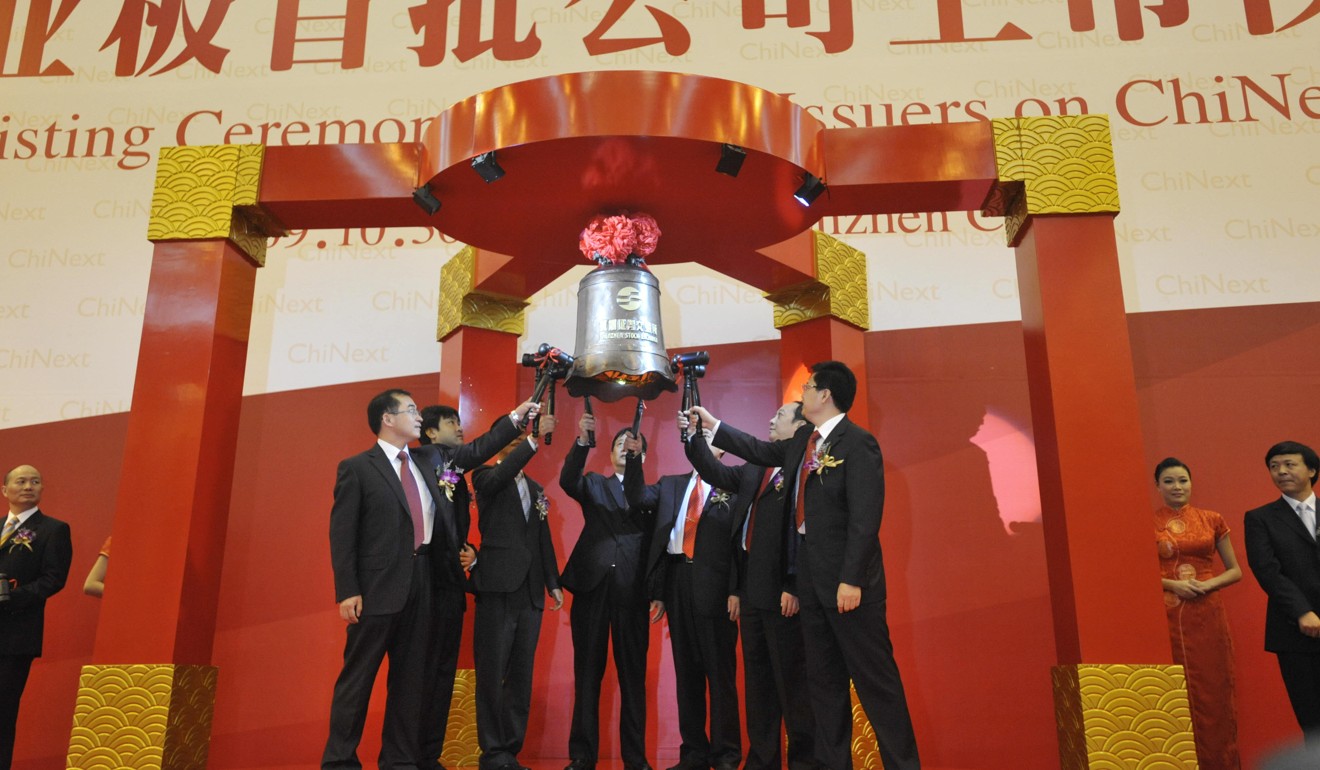
ChiNext board celebrates birthday as mainland start-ups clamour to list abroad
Once touted as China’s answer to the Nasdaq exchange, the Shenzhen-based bourse is yet to spawn a home-grown technology giant
On Monday, the ChiNext board – the mainland exchange that set out to emulate the US’ Nasdaq – celebrated its eighth anniversary.
State-owned media marked the occasion by using a slew of data to demonstrate its success in fostering the growth of technology start-ups.
But they conveniently glossed over the fact that dozens of prospective small Chinese firms are queuing up to list overseas, leaving domestic bourses red-faced at a time when Beijing is pressing them to speed up innovation.
So far this year, 121 firms have raised 44.6 billion yuan (US$6.7 billion) via initial public offerings on the ChiNext board of the Shenzhen Stock Exchange.
But the amount raised pales compared with the fact just two mainland technology businesses – micro-lender Qudian and ZhongAn Online Property and Casualty Insurance, China’s first online-only insurer – netted a combined US$2.4 billion by floating IPO shares outside the mainland between late September and mid-October.

A rising demand for financing has prompted a clutch of fintech firms to kick off their overseas listing processes, most of them aiming to complete fundraising in the next 12 months.
PwC partner Gao Jianbin said most of the firms would aim to list in the United States, while Hong Kong was also an option for many of them.
Among the listing prospects are Jianpu Technology, known as Rong360, which filed its IPO proposal to the US Securities and Exchange Commission about a week ago, with the aim of raising US$200 million on either the New York Stock Exchange or the Nasdaq.
It is following in the steps of a wave of Chinese fintech companies looking to go public in the US, including peer-to-peer lenders Pai Pai Dai and He Xin Dai.
“Cash-hungry businesses can’t afford time to await a green light from the A-share regulator,” said Cao Hua, a partner at Unity Asset Management. “But an overseas listing spree is definitely not the scene the domestic authorities want to see.”
It will be a huge waste of financial resources if the country’s own capital market fails to see the birth of a Chinese heavyweight
The China Securities Regulatory Commission (CSRC) still bars unprofitable companies from launching IPOs on the Shanghai and Shenzhen stock exchanges.
The grim reality is that a large portion of the country’s tech start-ups have yet to make profits.
Two years ago, the securities regulator was studying a plan to scrap the profitability requirement so as to give thousands of start-ups a much-needed financing opportunity, but the liberalisation never came to pass.
The other major obstacle to domestic IPOs lies in the variable interest entity (VIE) structure.
Under the VIE structure, a Chinese firm and a foreign venture-capital fund sets up an offshore vehicle which, through one or more foreign investment subsidiaries in the mainland, enters into contracts with domestic firms. The contracts give effective control of the mainland companies to the offshore vehicle.
Those embarking on the VIE structure are regarded as foreign-funded businesses and can therefore only seek stock market listings abroad. They have to restructure their ownership to comply with the mainland rules before applying for A-share IPOs.
Indeed, nearly all the country’s biggest and most promising unlisted technology companies are poised to conduct IPOs outside the home market.
Two years ago, the lofty valuations on the ChiNext exchange attracted many US-listed Chinese companies to relist.
In a typical case, the founder or major shareholder would take the firm private before restructuring the ownership so as to pursue a reverse merger deal, known as backdoor listing, in China.
At the beginning of 2016, the CSRC tightened its oversight of backdoor listings to avoid potential boom-to-bust cycles driven by the so-called “shell” companies being targeted by unlisted businesses to engineer reverse merger deals.
On October 30, 2009, when the first batch of 28 start-ups debuted on the ChiNext, there were hopes that the new board would go on to spawn more than 1,000 profit starts, buoyed by the mainland’s growth potential. Many thought it would lead to the birth of China’s own equivalents of Microsoft and Netflix.
The mainland may have its answers to global technology giants like Amazon.com, but all of the home-grown internet behemoths, including Alibaba, owner of the South China Morning Post, are listed outside mainland China.
To date, the ChiNext market is home to 690 stocks with a combined value of 5.55 trillion yuan, accounting for 9.5 per cent of the total A-share market value.
But the possibility of a tech giant on the ChiNext market remains, for now, a pipe dream.
“It will be a huge waste of financial resources if the country’s own capital market fails to see the birth of a Chinese heavyweight,” said Shiva Investment fund manager Zhou Ling. “The market is awash with cash and they can be better used to reinforce the growth of start-ups.”

